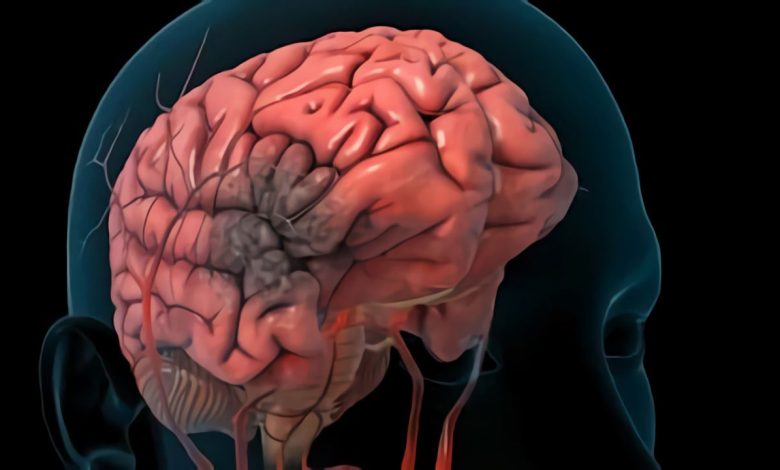Anoksičeskoe brain damage: what is this, the cause of the, symptoms, diagnostics, treatment, prevention

Anoxic brain damage
Description of anoksicheskogo brain injury
Anoksicheskie brain damage occurs, When the brain is not getting enough oxygen for several minutes or more. Without oxygen, brain cells begin to die after about four minutes..

Anoksicheskogo causes brain damage
Anoksicheskoe brain damage can occur in the following cases:
- Rich oxygenated blood cannot reach the brain (eg, When a blood clot prevents blood flow to the brain, or when the blood pressure is too low, eg, during the shock or acute heart failure);
- Blood, that reaches the brain, does not contain enough oxygen (eg, Lung diseases is not enough blood is enriched with oxygen);
- The effects of poison or other toxins, that reduces the oxygen content in blood (eg, carbon monoxide poisoning).
Risk factors
Accidents and health problems, that increase the risk of brain damage anoksicheskogo:
- Cardiac arrest;
- Suffocation;
- Asphyxia;
- Drowning;
- Electrical shock;
- Defective gas equipment, which produces carbon monoxide (With);
- Heart attack;
- Cardiac arrhythmia (irregular heartbeat);
- Stroke;
- Brain Tumors;
- Drug use.
Symptoms of brain damage anoksicheskogo
Recovery after anoksicheskogo brain damage may be accompanied by problems and can take a lot of time. Chances of recovery depends on, How long the victim was subjected to a zero or low to ensure oxygen. Severe damage can lead to coma or vegetative state. After a moderate anoksicheskogo brain damage may occur:
- Headache;
- Confusion;
- Decreased concentration and attention span;
- Mood swings and/or altered mental status;
- Unsustainable loss of consciousness;
- Seizures;
- Parkinson's Disease, as syndrome;
- Abnormal twitching muscles.
Most people with mild brain damage usually recover most of his neurological functions, or learning to live successfully with disabilities.
Diagnosis of anoksicheskogo brain injury
The doctor asks about the symptoms and medical history, and performs a physical exam. Maybe, need to see a doctor, who specializes in problems of the brain.
Assays, that allow to know the degree of damage, and determine the part of the brain, which was damaged:
- Computed tomography of the head – X-ray examination, wherein the computer is used, to make detailed images of the brain;
- MRT – test, which uses magnetic waves, to make pictures of structures inside the head;
- Electroencephalogram (EEG) – test, which measures the electrical activity of different parts of the brain;
- SPECT scans – type of computer tomography, which explores the blood flow and metabolism in areas of the brain;
- Tests, used to assess optic, auditory and sensory perceptions.
Treatment of anoksicheskogo brain injury
Anoksicheskogo treatment of brain damage depends on the cause. May initially be used barbiturates, to slow down brain activity. Steroids and other medications can be used, to reduce swelling, that occurs when brain tissue injury. This can help limit the extent of brain damage. The doctor also appoints pure oxygen, to provide them with the brain. Cooling the brain can be used, to help limit brain damage. Besides, hyperbaric oxygen treatment can be used in cases of hypoxia due to inhalation of carbon monoxide.
Rehabilitation
During rehabilitation the victim and his family will work with the following doctors:
- Physiotherapist – helps restore motor skills, such as walking;
- Specialist in occupational therapy – work to improve the daily skills, such as dressing and going to the toilet;
- Speech therapist – work on problems with speech;
- Neurologist – Tips on behaviour and treatment of emotional problems, associated with the trauma.
Recovery can take several months or even years. In many cases, a full recovery is never achieved. Generally, the sooner Rehab starts, the better the result.
Medication
Your doctor may prescribe the following reception of medicinal remedies:
- Antiepileptic drugs – for the treatment of recurrent stroke;
- Clonazepam (eg, Klonopin) – treatment for muscle cramps.
Prevention of anoksicheskogo brain injury
To reduce the risk of brain damage, necessary:
- Chew;
- Learning to swim;
- Supervise young children near water;
- Stay away from high-voltage electrical sources (including protect themselves from lightning);
- Avoid chemical toxins and drug paraphernalia;
- Check the devices for gas burning and device, producing carbon monoxide, as well as install carbon monoxide detectors.
Used sources
- Anoxic Encephalopathy, Zachary Messina; Angela Hayes Shapshak; Rebecca Mills. https://www.ncbi.nlm.nih.gov/books/NBK539833/
- Hypoxic Brain Injury Myriam Lacerte; Angela Hayes Shapshak; Fassile B. Mesfin. https://www.ncbi.nlm.nih.gov/books/NBK539833/
- Clinical pathophysiology of hypoxic ischemic brain injury after cardiac arrest: a “two-hit” model Mypinder S. Sekhon, corresponding author Philip N. Ainslie and Donald E. Griesdale https://www.ncbi.nlm.nih.gov/pmc/articles/PMC5390465/
